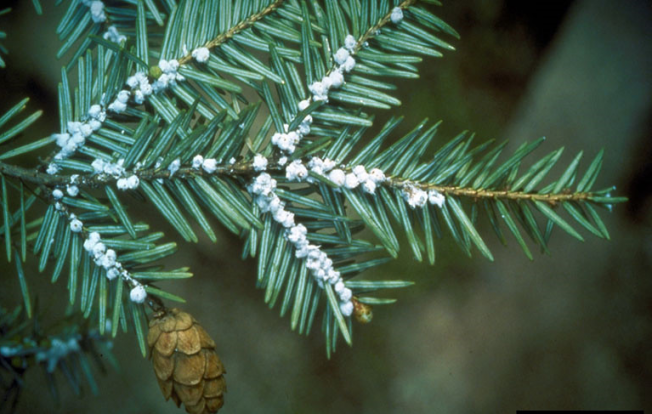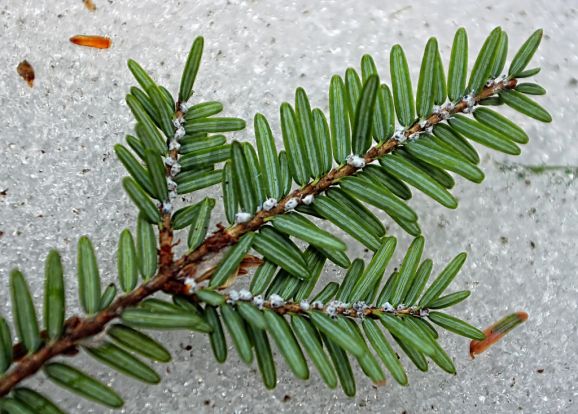Arbor-wellness: Hemlock Woolly Adelgid
Hemlock trees are very susceptible to a small white woolly looking insect called the Hemlock woolly Adelgid. They can build populations up quickly and when they are very active in a region, cause widespread death of hemlock trees when not treated. On Fir trees, there is a related insect called the Balsam Woolly Adelgid that is found largely on the trunk stems and small twigs, where they feed voraciously, weakening the tree quickly.
Treatments are somewhat problematic because of how waxy and woolly their outer “layer” is. We often use alternate treatments besides spraying for them, which gets better results and we don’t harm the good guys as much. Click here to see how Arborwell can help to protect your Hemlocks and Fir trees from either of these problems.
Adelgids are making a comeback
One insect that is not talked about much but can become very problematic is a tiny, fuzzy white insect called Adelgid. They feed almost exclusively on conifers, but each type is fairly limited in the number of different tree types it feeds on. They feed on the sap and weaken the trees. When populations are high enough, they will eventually kill the tree, especially on hemlocks.
Hemlock Woolly Adelgid
These feed on the needles and small twigs of hemlock tree, forming masses of white cottony spots on hemlocks. They are most prevalent on Eastern hemlock trees and are less of a problem on the Western varieties of this tree.
Pine Bark Adelgid
Most common on thin barked pine trees, they tend to cover the bark close to where branches extend from the trunk, but can fill the entire trunk when the population builds up, creating an almost snow-like affect on the trunk. These adelgids weaken the tree when present in large numbers, but are often not fatal, and they tend to favor stressed tress, so maintaining healthy pine trees goes a long way to keeping this insect in check.
Cooley Spruce Gall Adelgid
They are found on Colorado blue spruce, Douglas fir, and Englemann and Sitka spruce. They feed at the tips of small twigs and form a unique looking gall. Once they mature and leave, the gall turns brown and dies, leaving tips of the tree looking unsightly. Rarely do they need treatment, but can be warranted when the population is high.
Balsam Woolly Adelgid
This tiny sucking insect was introduced to North America from Europe. It is a serious pest of true firs in forests and landscape, and in Christmas tree production. Balsam woolly adelgid feeds on the stems of true firs. White or grayish cotton like masses of eggs or newly hatched purplish-black insects can be found on the twigs, branches, or trunk. Heavy adelgid infestations may cover the entire trunk. The feeding insects cause the tree to form swollen, knob like areas at nodes and tips of infested branches. Adelgid infestations weaken trees, cause foliage to become sparse, and can kill trees. This is a serious pest in the forest and common on most firs in landscaped areas, Balsam fir and subalpine fir are particularly susceptible. There are two to four generations per year. We can help you determine if adelgids are a problem on your hemlocks, pines, firs or other conifers.
Fill out the form below to Contact your Arborwell arborist and schedule an inspection.

